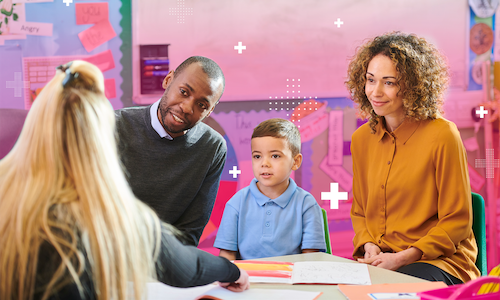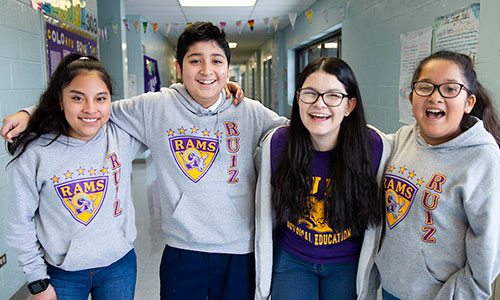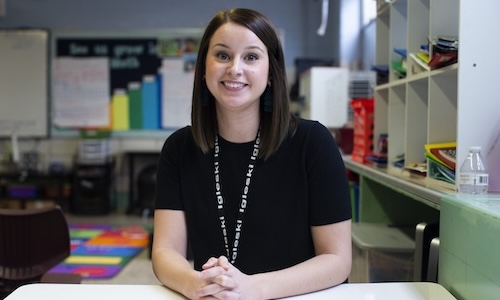
Even while schools were still closed and many American students were learning virtually, researchers were already studying what came to be called COVID learning loss, or unfinished learning. This has included several past reports by NWEA, including on the first full year post-COVID, the specific effects on the youngest learners, how learning loss hit lower-scoring students especially hard, and the struggles American schools have faced in helping students rebound and recover. What hasn’t been as well documented is science learning loss following COVID-19 school closures.
Most, if not all, of the research on COVID learning loss has focused on math and reading achievement. Science has been conspicuously absent, which is understandable given students are tested in reading and math far more often than in science, social studies, or even writing, and the fact that many assessment companies do not even offer a science test.
This imbalance is also reflected in how instructional time is allocated in areas outside of math and reading during the school day. A 2018 survey found science received an average of 27 minutes of instructional time per day compared to 82 minutes in reading and 63 minutes in math. In our recent research, which was released on September 17th, we sought to give science its due by analyzing how a sample of American students fared following the outbreak of COVID-19 and its related school closures.
Doing so ended up being trickier than we expected. For one, far fewer students take the MAP® Growth™ science test than the reading or math test. But even in those schools that do administer MAP Growth Science, they do so less frequently (e.g., in the spring but not the fall) and in fewer grades (e.g., fifth but not fourth). As a result, our science findings are less nationally representative than those from the math or reading reports referenced above.
In the end, we examined the science score trends for a sample of 400,451 students in 621 schools that a) consistently administered MAP Growth Science from spring 2017 through spring 2024 and b) consistently tested the same grades within those schools (i.e., if grade 3 was tested in 2017, the school was also required to test grade 3 consistently from 2018 to 2024). This resulted in a sample that was more rural (38%) and suburban (41%) than the nation overall (28% and 32% as of 2019–2020, respectively).
Results
To evaluate the degree of science learning loss following COVID-19 school closures, we examined scores in spring 2021 and spring 2024 compared to those from the same schools in spring 2019. In terms of metrics, we referred to these as achievement gaps between pre- (spring 2019) and post-COVID (spring 2021 and 2024) school years. Figure 1 presents these achievement gaps between spring 2019 and the two post-COVID school years.
Figure 1. Science achievement gaps in 2021 and 2024
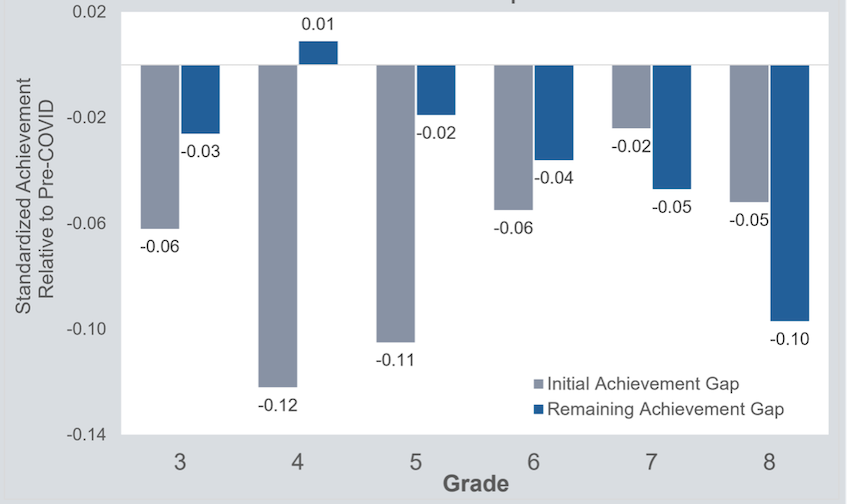
A few things are immediately clear from Figure 1. First, all students experienced science learning loss following COVID-19 school closures by spring 2021, with students in fourth and fifth grade hit hardest. Second, by spring 2024, elementary students had largely rebounded back to spring 2019 levels. However, the same cannot be said for middle school students, especially seventh- and eighth-graders, who scored even further behind in spring 2024 than their same-grade peers in spring 2019 or spring 2021.
It’s important to emphasize that these mean-score differences can be misleading. Although the eighth-grade difference of .10 standard deviations might seem small by traditional metrics for effect sizes, this gap would take three months of typical eighth-grade growth to close due to the relatively slow rate of middle school growth. Table 1 presents these same mean-score differences alongside the number of typical months of instruction it would take to close these gaps.
Table 1. Achievement gaps and months to catch up by grade
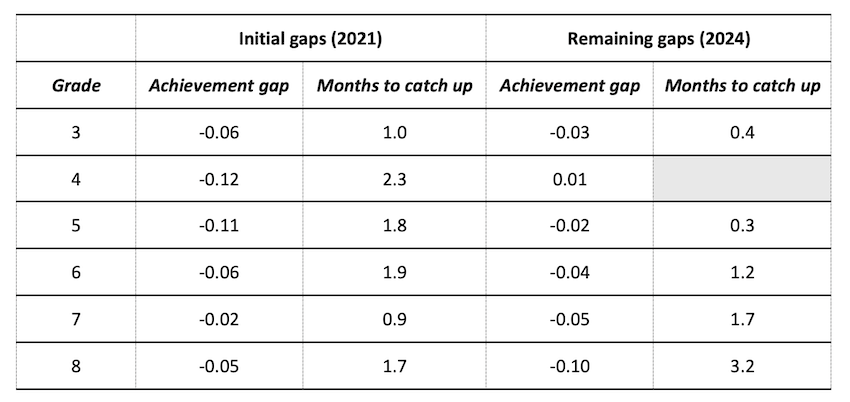
(Note: The greyed-out cell indicates that the group has exceeded pre-COVID achievement levels.)
And finally, while not represented above, it’s important to highlight that some of the most concerning findings in science relate to Hispanic middle school students. We don’t know why, but Hispanic students, who were roughly 22% of the students in our sample, continued to fall further behind even into the 2023–2024 school year. In spring 2021, a Hispanic eighth-grader needed the equivalent of 3.4 months of instruction to catch up to the overall average score from spring 2019. By spring 2024, that number had ballooned to 6.3 months!
Discussion
Something that continues to vex us as we seek to better understand science learning loss is why the size of the science achievement gap is so much smaller than the those for math and reading (in terms of effect sizes). One possible explanation may be the smaller amounts of instructional time schools tend to spend on science (i.e., an average of 27 minutes per day compared to 82 minutes in reading and 63 minutes in math). Going from 27 minutes of instruction prior to the pandemic to zero when schools were closed could simply have been a smaller distance to fall than going from 82 minutes to zero in reading. Even if our science sample represents the schools most dedicated to science, and therefore taught science for an impressive 45 minutes per day, going to zero would still be a smaller drop in instructional time than going from 63 minutes to zero in math. Although this might explain a smaller drop in scores from 2019 to 2021 or 2024, it’s far from positive news regarding science scores.
Second, it’s also possible that science scores did not drop by as much because of the nature of how science is taught compared to the structure of the MAP Growth Science test. The MAP Growth Science test covers topics of life science, earth and space sciences, and physical science. But it’s possible that in any given grade, schools focus their teaching on just one of these areas and save the others for subsequent years. For example, perhaps the fifth-grade teachers in our sample mostly focus on life sciences and, as a result, fifth graders missed this life science instruction during the pandemic. We would expect this instructional loss to matter much less to student performance on items related to earth, space, or physical sciences, the net result being a smaller drop in scores than if the test were solely a measure of life science.
Recommendations
Just as with math and reading, there are no easy solutions to making up for science learning loss following COVID-19 school closures, and doing so will be even more challenging as ESSER funds come to an end. But beyond the standard recommendations of tutoring and summer school, we’ve become intrigued by another path forward that might help mitigate learning loss in science and math or reading at the same time: the integration of science into math or reading instruction.
The research on this is far from definitive, but one of the challenges with science has been “finding time” for it in the school day. Too often instructional hours are seen as a zero-sum game, with more hours for reading meaning fewer for recess, art, or music. But when science is integrated into literacy or language arts instruction, science learning can happen outside of the minutes devoted to it. What’s more, some evidence suggests integration can accelerate learning in both reading and science, thereby helping students recover in multiple domains simultaneously. In the coming months, this is an area we at NWEA hope to dive into in greater depth.

